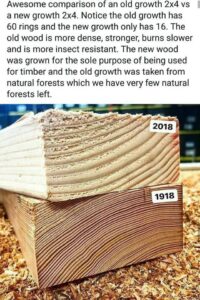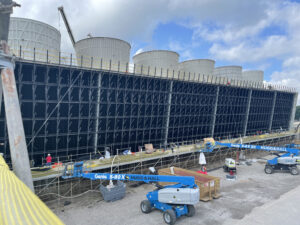Why FRP is the Best Choice for Your Cooling Tower Conversion
 The team at Cooling Towers, LLC are experts in converting outdated, wooden cooling towers to fiber-reinforced polymer, also known as FRP. It has been used as a casing material for quite some time, and today’s FRP materials offer even greater tower loads, with a host of other benefits such as resistance to corrosion and chemical attack. However, we realize that owners want the most cost-effective cooling tower materials for the money. Read on to learn why FRP is the best choice for your cooling tower conversion.
The team at Cooling Towers, LLC are experts in converting outdated, wooden cooling towers to fiber-reinforced polymer, also known as FRP. It has been used as a casing material for quite some time, and today’s FRP materials offer even greater tower loads, with a host of other benefits such as resistance to corrosion and chemical attack. However, we realize that owners want the most cost-effective cooling tower materials for the money. Read on to learn why FRP is the best choice for your cooling tower conversion.
What is FRP?
In the 70’s and 80’s cooling tower companies were seeking alternative, cost-effective building materials for their towers that would provide greater strength than the existing materials that were typically used. At that time, towers were usually constructed of wood, steel, or concrete. However, FRP had been successfully used in pipes and fan stacks and had been dropping in price over time. It only made sense to use it in new tower construction and to convert older, wooden towers that were no longer operating efficiently, or where safety was a concern.
FRP is defined as a polymer that is reinforced with fiber and falls into a category referred to as composite materials. These are made by dispersing particles of one or more materials to another material to form a continuous network around them. They are anisotropic, meaning the material shows different properties in different directions, whereas aluminum and steel are isotropic, meaning the material shows the same properties in all directions. This gives FRP superior mechanical properties, including increased impact resistance, strength, flexibility, and ability to carry higher loads.
The Problem With Today’s Lumber
 Today’s lumber is typically harvested from fast growing tree plantations as opposed to the old growth wood harvested from massive virgin timberlands across the globe. The result is a poorer quality and less sturdy piece of lumber. Old growth lumber trees age longer from indirect sunlight and competition from other trees in untouched forests for hundreds of years. New growth lumbers growth rings are less tightly packed and less useful. Not only has the quality gone down but the prices are soaring higher than ever before.
Today’s lumber is typically harvested from fast growing tree plantations as opposed to the old growth wood harvested from massive virgin timberlands across the globe. The result is a poorer quality and less sturdy piece of lumber. Old growth lumber trees age longer from indirect sunlight and competition from other trees in untouched forests for hundreds of years. New growth lumbers growth rings are less tightly packed and less useful. Not only has the quality gone down but the prices are soaring higher than ever before.
(Picture 17 in FRP Conversions File)
What Are the Benefits of FRP?
 FRP offers a higher ratio of strength to density as well as improved magnetic, electrical, and thermal properties. The material also has a host of other benefits such as:
FRP offers a higher ratio of strength to density as well as improved magnetic, electrical, and thermal properties. The material also has a host of other benefits such as:
- Exceptional resistance to corrosion and chemicals
- Exceptional fire resistance.
- Non-conductive (resistant to lightning).
- High impact resistance.
- Higher quality than lumber available today.
- Resistance to extreme weather and temperatures.
- Inert to micro and biological organisms.
- Strength for better creep and fatigue resistance.
- Does not rot or decay. Picture 5 inspections file
- Less maintenance and downtime.
- Environmentally friendly.
- Lightweight and easy to transport.
- Easier and quicker to install.
FRP Testing in Cooling Towers
FRP has been comparison tested with other cooling tower materials many times in various applications. A study conducted by the Journal of Mechanical Engineering Research concluded that FRP was the best structural material for cooling towers due to superior performance in an environment that was sea water corrosive. It was conducted with an advanced evaluation of the applicable materials with advantages and disadvantages of different sets of materials. The results were considered for cost estimation. They were analyzed due to the slightly higher cost of FRP compared to the saved maintenance and durability in hostile environments. The full study results can be read here.
Why Cooling Towers LLC. and FRP are the Best Choice for Your Cooling Tower Conversion
FRP structural components can be made in the exact same dimensions as the material they are replacing, so there are typically few modifications required to the original cooling tower design. The turnaround time for construction is comparable to wooden replacements, so the labor costs are about the same. FRP may be slightly more expensive than wood, but the longevity and other benefits of the upgrade far outweigh the initial cost difference.
Typically, an FRP conversion is performed in conjunction with an upgrade of the existing internal cooling tower components, such as the fill media and drift eliminators. These components must be removed to access the cooling tower structure. This presents the perfect opportunity to upgrade to new technology that is safer and more efficient.
 Our vast experience with cooling towers has proven that pultruded FRP components are the best choice for cooling tower conversions. We have converted countless cooling towers that were rotting or otherwise deteriorating to safer, more efficient towers. FRP conversions increase the structural integrity of your cooling tower, while increasing its overall performance. Contact our cooling tower experts today to learn more about how we can upgrade your cooling tower to perform more efficiently and increase its service life!
Our vast experience with cooling towers has proven that pultruded FRP components are the best choice for cooling tower conversions. We have converted countless cooling towers that were rotting or otherwise deteriorating to safer, more efficient towers. FRP conversions increase the structural integrity of your cooling tower, while increasing its overall performance. Contact our cooling tower experts today to learn more about how we can upgrade your cooling tower to perform more efficiently and increase its service life!
